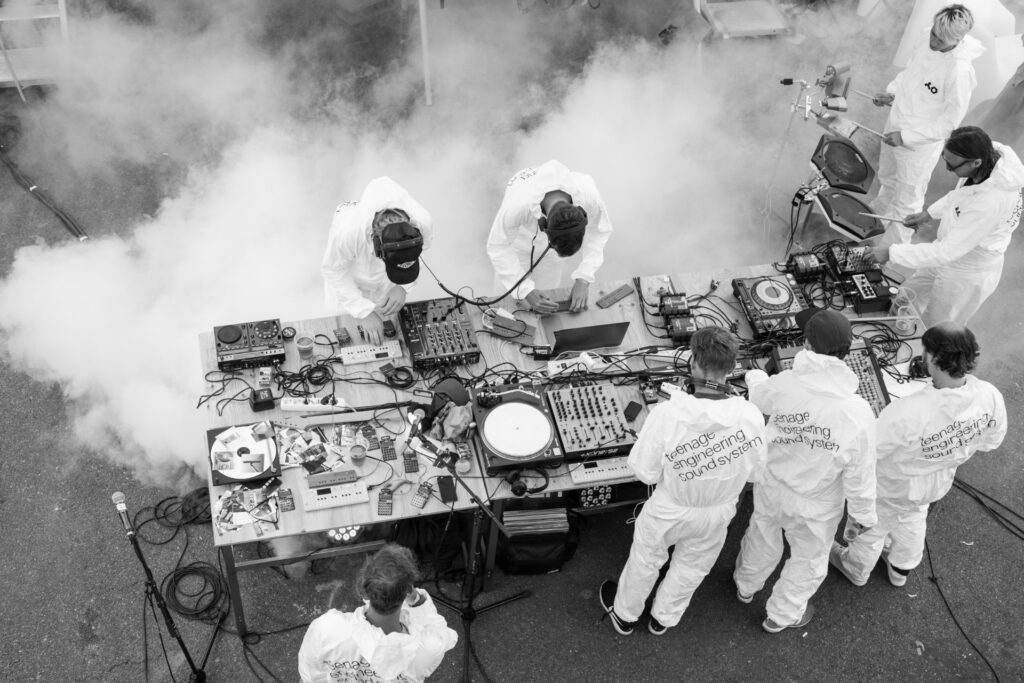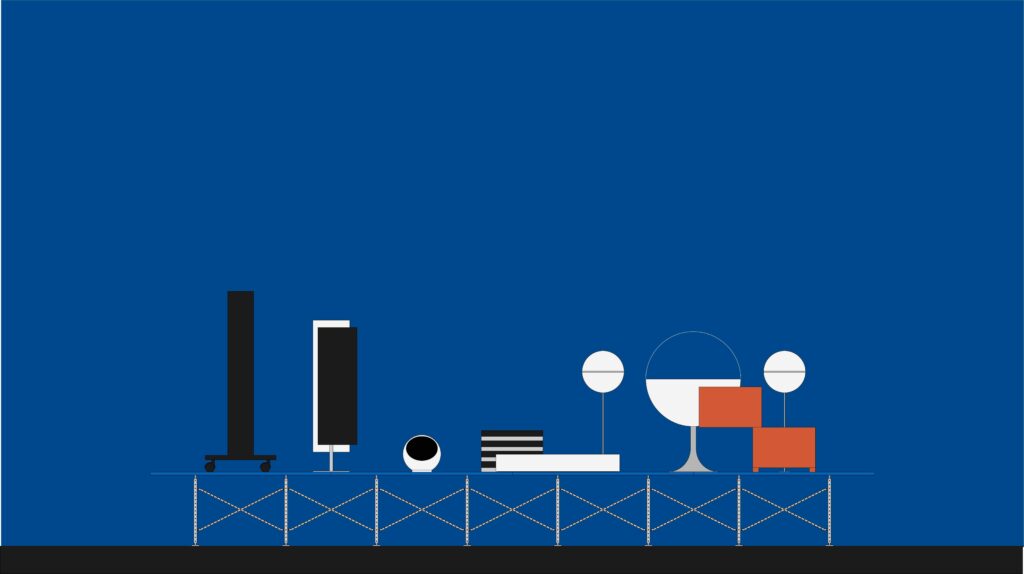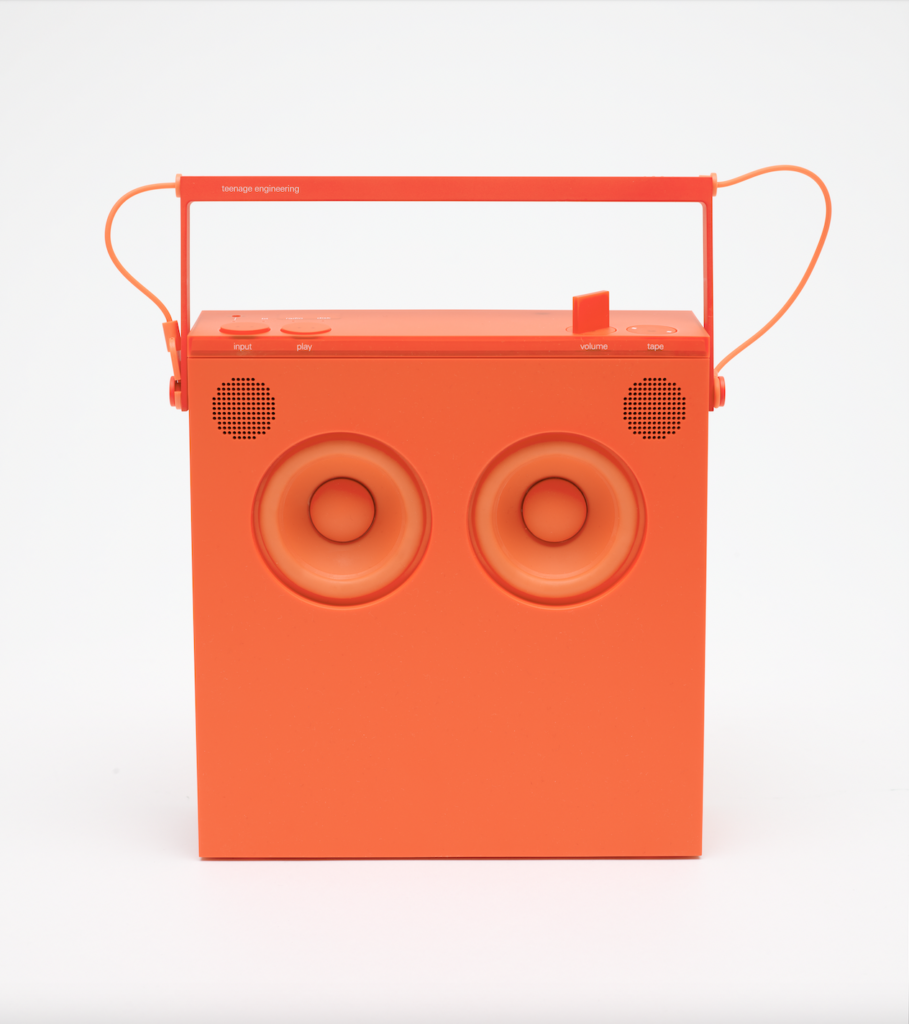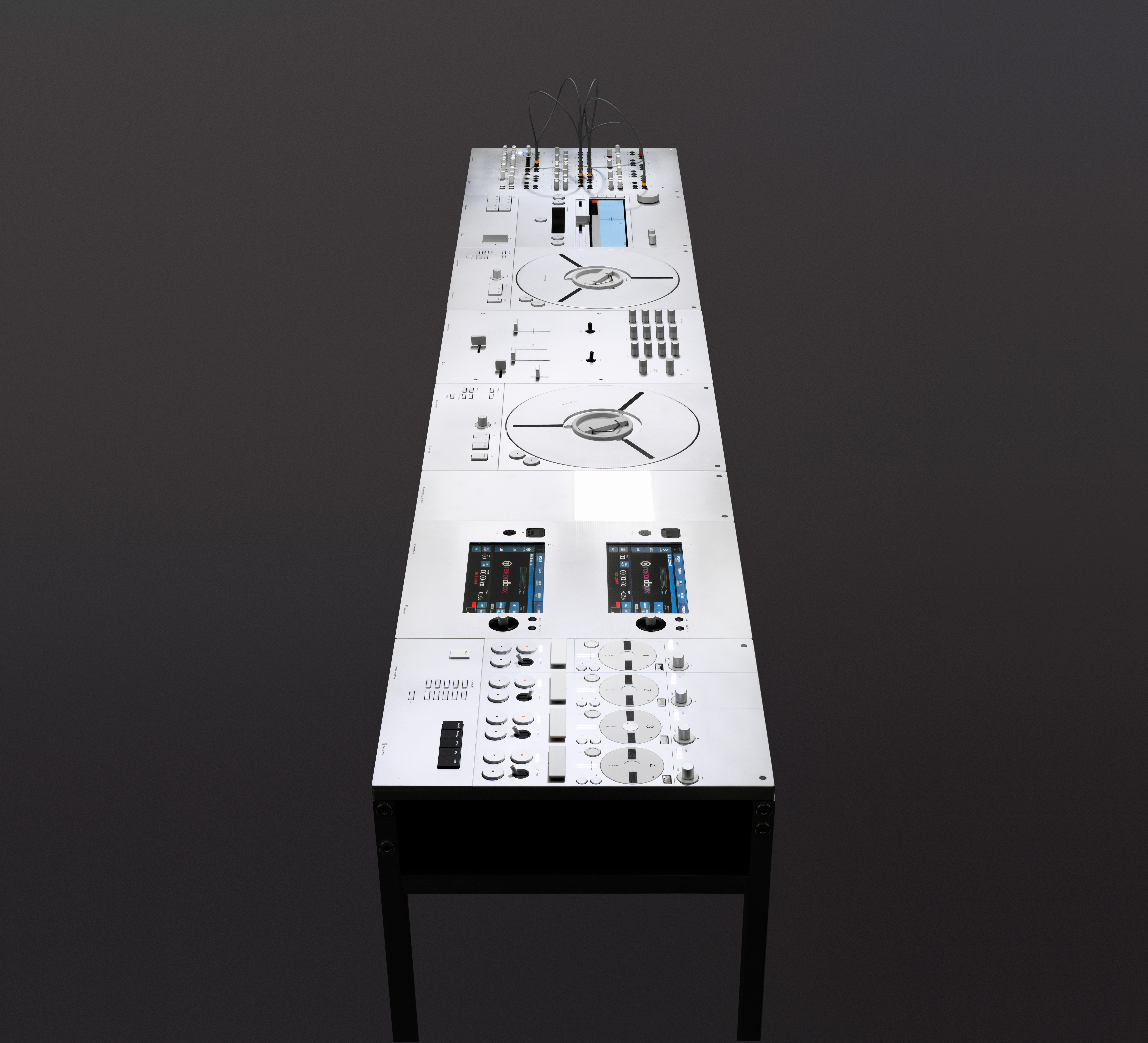Jesper Kouthoofd, head of design, founder, and CEO of teenage engineering, brings an explorer’s mindset to everything he approaches — from electronic products and graphic design to his Hammond organ and the gallery environment for SFMOMA’s exhibition Art of Noise. Curator of Architecture + Design Joseph Becker spoke with Kouthoofd to learn about his inspirations, his work style, and, perhaps what some fans are most curious about, the details of his personal sound system. (The interview has been edited for length and clarity.)
Jesper Kouthoofd 是青少年工程的设计主管、创始人兼首席执行官,他将探索者的心态带入他所接触的一切——从电子产品和平面设计到他的哈蒙德风琴和 SFMOMA 展览“噪音艺术”的画廊环境。建筑+设计策展人 Joseph Becker 与 Kouthoofd 进行了交谈,了解他的灵感、他的工作风格,以及也许一些粉丝最好奇的,他个人音响系统的细节。 (为了篇幅和清晰度,采访内容已被编辑。)
Joseph Becker: Where does the name teenage engineering come from?
约瑟夫·贝克尔:青少年工程学这个名字从何而来?
Jesper Kouthoofd: It comes from a song from almost 20 years ago by a Swedish band called Soundtrack of Our Lives. In the song “Teenage Angst,” it sounded to me that he was singing “teenage engineering.” We were building a little device, like what an Arduino is today, and had to come up with a company name and we picked teenage engineering. The company culture is like when you’re a teenager, you have this energy and will to try things, but you don’t have the full knowledge or skillset. It’s this discovery phase in life: going all in with open eyes and an open mind. teenage engineering is an attitude like, “Maybe we haven’t done it before, but let’s try. Let’s just do it.”
Jesper Kouthoofd:它来自大约 20 年前瑞典乐队 Soundtrack of Our Lives 的一首歌曲。在歌曲“青少年焦虑”中,我听起来他唱的是“青少年工程”。我们正在构建一个小设备,就像今天的 Arduino 一样,必须想出一个公司名称,我们选择了青少年工程。公司文化就像你十几岁的时候一样,你有精力和意愿去尝试,但你没有完整的知识或技能。这就是人生的这个发现阶段:睁大眼睛、开放思想全力以赴。青少年工程是一种态度,“也许我们以前没有做过,但让我们尝试一下。我们就这么做吧。”

青少年工程团队成员;照片:青少年工程
“teenage engineering is a good reminder to all of us to never get old — stay curious, stay naïve, and try new things.”
“青少年工程学很好地提醒我们所有人永远不要变老——保持好奇心、保持天真并尝试新事物。”
Becker: It’s like you’re harnessing some beautiful naïveté. You haven’t been bogged down by life telling you that you can’t do things.
贝克尔:就像你在利用一些美丽的天真。你并没有因为生活告诉你你不能做事而陷入困境。
Kouthoofd: Or how hard things really are. It’s exactly that. Naïve will. It’s what we discovered when we made our first product. We thought we were reaching 99% completion and then, oh, we have a thousand percent left to do with the manufacturing and all that. teenage engineering is a good reminder to all of us to never get old — stay curious, stay naïve, and try new things.
Kouthoofd:或者说事情到底有多困难。正是如此。天真的意志。这是我们在制造第一个产品时发现的。我们以为我们已经完成了 99%,然后,哦,我们还剩下 1000% 的时间来处理制造之类的事情。青少年工程学很好地提醒我们所有人永远不要变老——保持好奇心、保持天真并尝试新事物。
Becker: What were you doing before teenage engineering?
贝克尔:在青少年工程学之前你在做什么?
Kouthoofd: I went to school to study graphic design. I trained in the classic methods, using the camera and making everything by hand. I started doing record sleeves when I was 15. I got bored of that and wanted to get into advertising because it offered bigger budgets, more interesting projects. It was the early nineties when advertising was in a good place, with interesting people, creative campaigns, and some legendary commercials. I was an assistant art director on the Diesel Jeans campaign, which was quite big then. Then I started Acne and companies within Acne, like Netbabyworld, which was a gaming thing.
Kouthoofd:我去学校学习平面设计。我接受了经典方法的培训,使用相机并手工制作一切。我 15 岁时开始制作唱片套。我对此感到厌倦,并想进入广告行业,因为它提供了更多的预算、更有趣的项目。九十年代初是广告业盛行的时期,有有趣的人物、创意十足的广告活动和一些传奇的广告。我是 Diesel Jeans 活动的助理艺术总监,当时该活动规模相当大。然后我创办了 Acne 和 Acne 内部的公司,比如 Netbabyworld,这是一个游戏公司。
I’ve always followed new software, starting with Adobe Illustrator 88 in 1988, and how I could use the computer as a tool. The arrival of After Effects software allowed me to move graphics, which was how I turned to directing commercials and film production. I also always wanted to do CAD [computer automated design]. I started product industrial design because there was good software available. Interestingly, when I design nowadays, I sketch everything in 2D as I did when I started.
我一直关注新软件,从 1988 年的 Adobe Illustrator 88 开始,以及如何使用计算机作为工具。 After Effects 软件的出现使我能够移动图形,这就是我转向指导广告和电影制作的方式。我也一直想做 CAD(计算机自动化设计)。我开始产品工业设计是因为有很好的软件可用。有趣的是,当我现在设计时,我会像刚开始时一样以 2D 形式绘制所有内容。
Becker: Acne was such an important company that had all of these tentacles. You created this ecosystem of cultural production. It seemed inevitable that you would then want to make something that could be handheld like a product.
Becker:Acne 是一家如此重要的公司,拥有所有这些触角。你们创造了这个文化生产的生态系统。似乎不可避免的是,你会想要制造一些可以像产品一样手持的东西。
Kouthoofd: I left advertising because I felt it used creativity only for print and film. Why wouldn’t we apply this creativity to making our own products? If you are a creative person, you don’t have to be stuck in one medium. When I design a product, it’s like making a film. You tell a story. A product can be entertaining and be a tool, which is a different way to think about industrial design.
Kouthoofd:我离开了广告业,因为我觉得它只在印刷品和电影中发挥创造力。我们为什么不运用这种创造力来制造我们自己的产品呢?如果你是一个有创造力的人,你不必局限于一种媒介。当我设计产品时,就像拍电影一样。你讲一个故事。产品可以是娱乐性的,也可以是工具,这是思考工业设计的不同方式。

青少年工程,噪音艺术的设计概念,2023
Becker: Is that why you wanted to be part of Art of Noise?
贝克尔:这就是你想成为噪音艺术的一部分的原因吗?
Kouthoofd: Exactly. Culture and meeting people like you and understanding how that world works. Why do you do it? How do you think about things? Why are you interested in the stuff you do? It’s exploration. The adventure is so much bigger than developing and releasing a product. That discussion with the audience is super rewarding. If I discuss with you what teenage engineering is, I might change my mind tomorrow just to surprise you. When everything is cemented, it gets a little boring. The brain wants to be entertained. You still want to know a person or company — to see something from them that’s familiar but new. That’s what we try to find in everything we do.
库胡夫德:没错。文化和结识像你这样的人并了解这个世界是如何运作的。你为什么要这么做?你如何看待事情?你为什么对你所做的事情感兴趣?这是探索。这次冒险比开发和发布产品要大得多。与观众的讨论非常有意义。如果我和你讨论什么是青少年工程学,我明天可能会改变主意,只是为了给你一个惊喜。当一切都固定下来时,就会变得有点无聊。大脑想要得到娱乐。你仍然想了解一个人或一个公司——从他们身上看到一些熟悉但新鲜的东西。这就是我们在所做的一切事情中努力寻找的目标。

青少年工程,Virgil Abloh,OB–4 Off-White 便携式蓝牙扬声器,带 FM 收音机2020;旧金山现代艺术博物馆,青少年工程学的礼物;照片:唐·罗斯
Becker: What are some influences and inspirations behind your work?
Becker:您的工作背后有哪些影响和灵感?
Kouthoofd: When I started doing industrial design, I said the design philosophy should be a mix between German and Italian. I set up restrictions when I design. I always work with simple geometric shapes, RAL colors — which is a 40-color scale — and try to adhere to German industrial standards. The Germans thought out a system years ago that still works. They did such a proper job that you don’t have to reinvent things. I stick to rules and try to understand them, because then I can become free again. Like with colors, I started with Pantone, the industry standard, but they have too many colors, so it takes weeks to pick the right blue. If you use RAL, it has only two blues — light blue and dark blue. It’s about efficiency in the process and the expression.
Koouthoofd:当我开始做工业设计时,我说设计理念应该是德国和意大利的混合。我在设计时设置了限制。我总是使用简单的几何形状、RAL 颜色(40 色标度)并尝试遵守德国工业标准。德国人多年前就想出了一个至今仍然有效的系统。他们做得非常好,你不必重新发明东西。我遵守规则并尝试理解它们,因为这样我就可以再次获得自由。与颜色一样,我从行业标准 Pantone 开始,但它们的颜色太多,因此需要数周时间才能选择合适的蓝色。如果你使用 RAL,它只有两种蓝色——浅蓝色和深蓝色。这是关于过程和表达的效率。
I connect colors to a meaning and then apply that to all products. If it’s orange or red, it means recording. Colors and shapes are also connected, so a triangle is always yellow, a square is blue, and a circle is red. It’s this universal understanding about color and shapes. We also don’t use capital letters and only write in lower case. It’s democratic — why should certain words have more meaning and be capitalized? That’s an old-fashioned way of thinking about communication.
Inspiration also comes from learning; you start to question things. For a couple of years now I’ve questioned the point system used in typography. It’s meaningless today. I want to convert it to millimeters because I work in the metric system. And car manufacturers, I ask them, “Why do you have a hood on an electric car? There’s no engine there anymore.” Yet all electric cars are designed with a hood. How stupid is that? They say, “No, it’s the crash zone.” Yeah, but you can solve that in other ways.

Becker: I’m excited about many pieces in the show, like the DJ deck you designed for Virgil Abloh. How did that come about?
Kouthoofd: Virgil knocked on our door in Stockholm and we had a nice dinner together. He had this dream of reinventing the DJ deck, so I said, “Okay, let’s build something and start to explore.” This deck was the test. He used it when he performed at Coachella. We built it in two months. It can be scary to work with a creative superstar like him, but he was super down to earth and friendly.
I’m shy and he was also a little bit shy. We connected in that way. We both liked to work and discover things with our hands. He always picked up things and put them together, bits and pieces that he found at our office or the studio. It was the start of a creative process together that we sadly couldn’t finish.
I learned a lot watching him work. Instead of formal meetings, emails, and presentations, I would text him a snapshot of the display. We would text back and forth. Some people hate emojis, but the thumbs up and thumbs down are so effective when you are in a sensitive creative process. I’ve adopted that.
Becker: You bridge the analog and digital world in such an interesting way. What is the draw?
Kouthoofd: For me it’s about the muscle memory that connects to the experiences you had when you were young. Maybe you turned a knob or did something with your hands that you never forgot. Many people use mechanical keyboards because they remember the feeling of typing on a typewriter or a vintage keyboard. That feels better to them than a flat keyboard or touch screen. Now it’s display screens everywhere. Some people believe the next OS is away from touch, with people moving and doing gestures in the air. I think we will have physical things that we touch. But that’s just me.
Becker: I wanted to get at this with the exhibition. We have this contemporary trade-off where we can carry all of our music with us in our pockets, but you interact with it through a touchscreen. There isn’t the tangibility of the past in most people’s experience, but you reintroduce that bodily memory in a visceral way that is really inspiring.
“teenage engineering is an attitude like, “Maybe we haven’t done it before, but let’s try. Let’s just do it.””
Becker: What devices do you use to listen to music?
Kouthoofd: I’m into Hammond organs, so I’m trying to learn that. I have a B-3. Before the Hi-Fi system, some people had an organ in the home, and that was the musical entertainment system.
My Hi-Fi system today is an AM-1 mixing console — that’s my pre-amplifier, so to say. Then I have, and really like, JBL’s 4435 Studio Monitor speakers — they’re quite big, each one-by-one meter — and two monoblock class D amplifiers, one amplifier per channel. For me, it’s not about audiophile quality. If you have a lot of amplification power you don’t have to only use it to play loud, you can use it to EQ [equalize] the sound. I’m a bit like a sound engineer. When I listen to music, I EQ a lot to compensate for the room, for reflections, etc. I use the mixing console to monoblocks and then use the TX-6, our little mixer, as a sound card if I play digital music. For my turntable at home, I have the EMT 950. It has a time code and it’s the one the BBC used in their broadcasting.
Becker: What are you currently listening to?
Kouthoofd: Gospel and Hammond recordings. It’s hard to find really, really good records. They’re usually live recordings, but that’s what I try to listen to. I’m getting old. I get that. I’m turning into this Hammond old fart.
Becker: The Hammond has that analog warmth, but it’s a precursor to the synthesizer.
Kouthoofd: Exactly. It is basically a synth. If you look at old Roland synthesizers, they try to replicate real instruments. The 303 was created to replace the bass player. It’s the same with every instrument we do. The journey is long. It can take decades until people discover, “Oh, I can use it in this way.” Like how they started to scratch on a turntable, and it ended up being the technique that everyone wanted. It’s this randomness that is interesting.